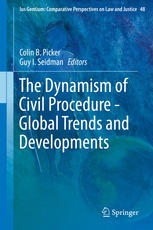

Most ebook files are in PDF format, so you can easily read them using various software such as Foxit Reader or directly on the Google Chrome browser.
Some ebook files are released by publishers in other formats such as .awz, .mobi, .epub, .fb2, etc. You may need to install specific software to read these formats on mobile/PC, such as Calibre.
Please read the tutorial at this link: https://ebookbell.com/faq
We offer FREE conversion to the popular formats you request; however, this may take some time. Therefore, right after payment, please email us, and we will try to provide the service as quickly as possible.
For some exceptional file formats or broken links (if any), please refrain from opening any disputes. Instead, email us first, and we will try to assist within a maximum of 6 hours.
EbookBell Team

4.4
102 reviewsThis book shows the surprising dynamism of the field of civil procedure through its examination of a cross section of recent developments within civil procedure from around the world. It explores the field through specific approaches to its study, within specific legal systems, and within discrete sub-fields of civil procedure. The book reflects the latest research and conveys the dynamism and innovations of modern civil procedure - by field, method and system. The book’s introductory chapters lay the groundwork for researchers to appreciate the flux and change within the field. The concluding chapters bring the many different identified innovations and developments together to show the field's ability to adapt to modern circumstances, while retaining its coherence even across different legal systems, traditions, fields and analytic approaches. Specifically, in this book the presence of dynamism is explored in the legal systems of the EU, France, the US, Brazil, Australia, the UK and China. So too that dynamism is explored in the contributions’ analyses and discussions of the changes or need for change of specific aspects of civil procedure including litigation costs, class actions, derivative actions, pleadings, and res judicata.
Furthermore, most of the individual contributions may be considered to be comparative analyses of their respective subjects and, when considered as a whole, the book presents the dynamism of civil procedure in comparative perspective. Those discrete and aggregated comparative analyses permit us to better understand the dynamism in civil procedure – for change in the abstract can be less visible and its significance and impact less evident. While similar conclusions may have been drawn through examinations in isolation, employing comparative analytic methods provided a richer analysis and any identified need for change is correspondingly advanced through comparative analysis. Furthermore, if that analysis leads to a conclusion that change is necessary then comparative law may provide pertinent examples for such change - as well as methodologies for successfully transplanting any such changes. In other words, as this book so well reflects, comparative law may itself usefully contribute to dynamism in civil procedure. This has long been a raison d'être of comparative law and, as clear from this book’s contributions, in this particular time and field of study we find that it is very likely to achieve its lofty promise.